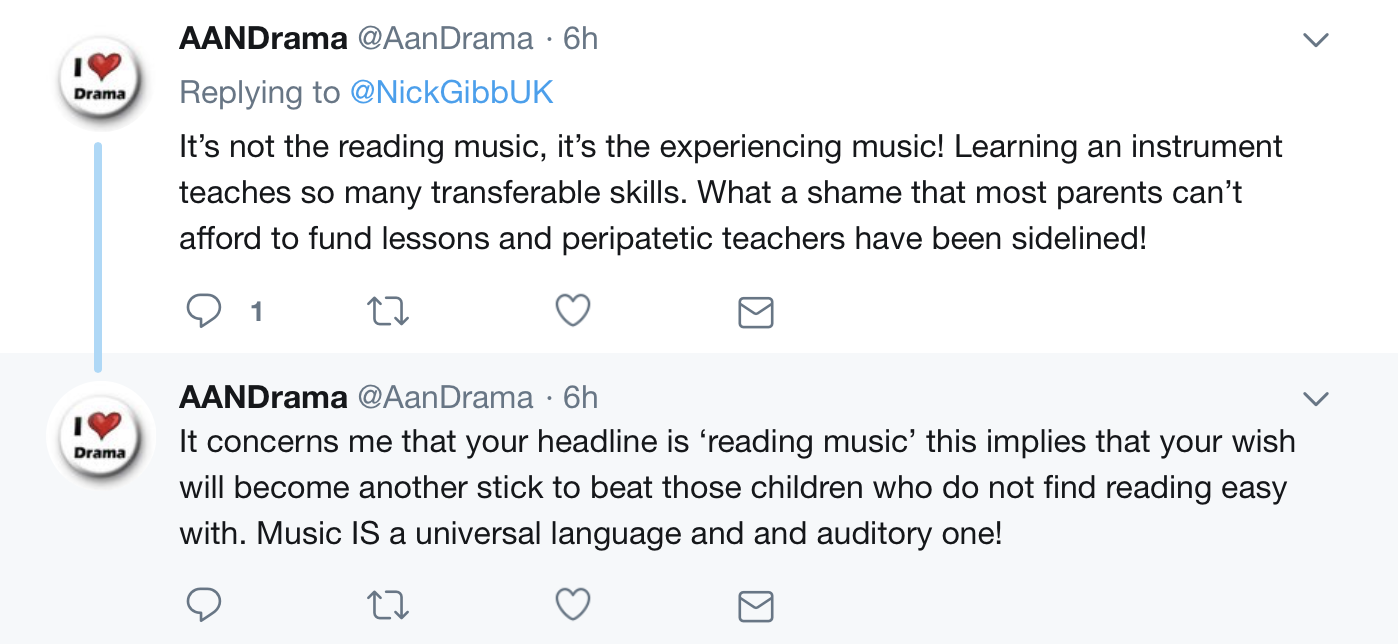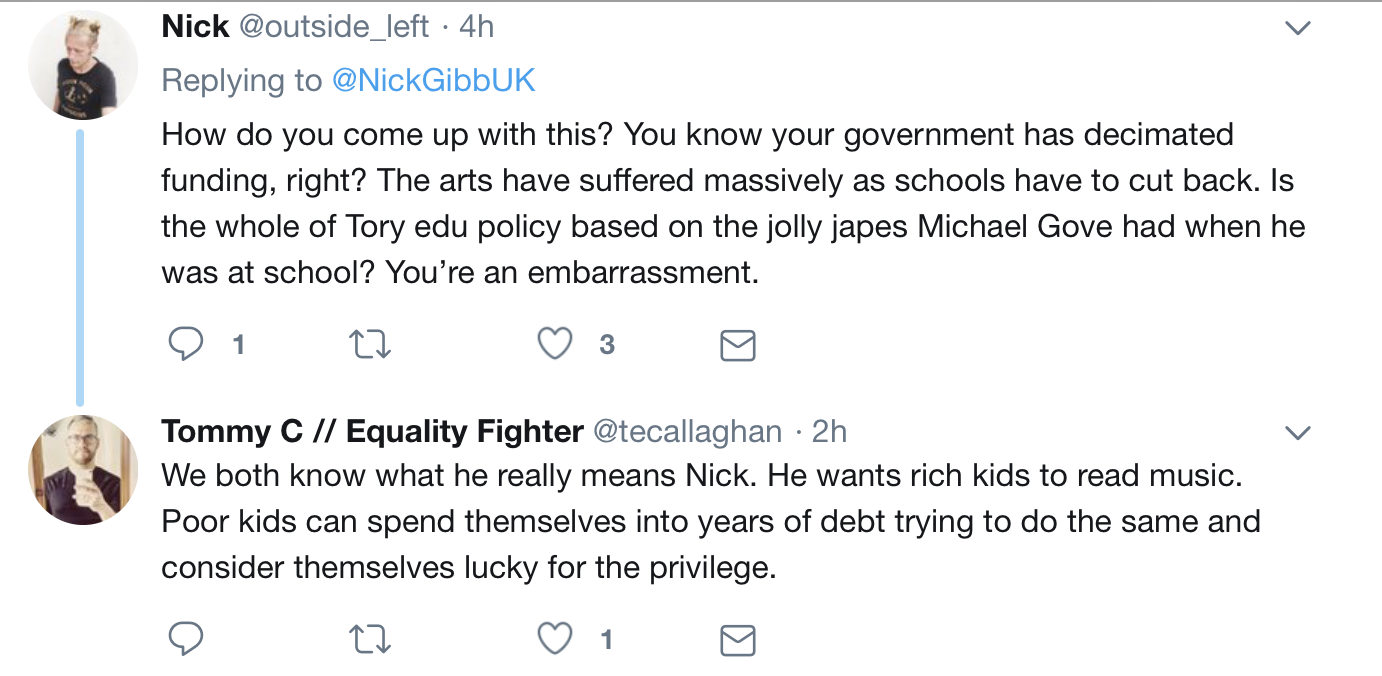What was the “Wider Opportunities” project, now First Access, are the schemes that have been put in place where a whole class learn an instrument together, normally for a year. It came about after the Labour Education Secretary David Blunkett gave a clear commitment that every child should play a musical instrument in the Blair Years. Credit where credit is due, Blunkett stuck to his word and schools got a variable experience of each child learning an instrument together. I worked for a local authority music service that implemented this scheme so I have first hand experience of setting up, carrying out and evaluating these projects. I still run quite a few in my school now. I have blogged about this a few years ago, today’s blog is to explain what tweaks we need to do to make these projects work better.
The basic idea is great. We all play an instrument together with an expert guiding us. The projects go wrong as soon as you encounter differentiation, practice, assessment, technique, logistics, accommodation, repairs, change in teacher, and a lack of aims. This sounds pretty stark but most of the projects have not been set up with enough thought concerning the little details. To get this right means we have to accept some uncomfortable things we would rather not deal with. It also means thinking about pedagogy and philosophy.
Differentiation
Everything goes well in your First Access lessons for about half a term and most the kids are are the same level. You buy a book like “Fiddle Time Joggers”, or “Recorder from the Beginning” or “Standards of Excellence”. You project the music on the interactive white board. This is easy! The kids are all learning! Why the heck didn’t we do this years ago?
After half a term, you’ve lost a third of kids who are struggling, a third think it is too easy and a third are kind of happy with what you are doing. You now have the Differentiation Problem and you have to come up with a solution that will appease children, parents, school leadership, the class teacher who is looking at you like a clueless puppy-dog and yourself. So you either 1) do nothing, 2) take out the more able to do something harder, 3) attempt to write a harder or easier part to what you are doing or 4) make new groups. This is pretty consistent for almost every type of instrument. I have taught classes of recorder, violin, cello, clarinet, trumpet, trombone, ukuleles, guitars, keyboards, djembes and Chinese Drums. We all end up with the difficulties but it is less of a problem with djembes and Chinese Drums. The differentiation problem seems to coincide with difficulties with pitch and musical literacy more than rhythm.
All three of my potential solutions have major costs as well as advantages. Number 1 is pretty lazy but actually isn’t as bad as you think because as soon as you split the group you have less time for each other and as soon as you split the music you have to teach two different things twice, leaving less time for students. What most teachers seem to do is stick with Number 1 as long as possible before moving to Number 2 at the end of the year with some small group teaching. Few people attempt Number 3 or Number 4; I do but it only works when you talk about…
…Practice
But you can’t even talk about this if, like most of the schools I have worked in, the children are unable to take the instruments home. This is the main reason, in my opinion, why some of the projects fail. The children can’t practice at home so make little progress. All that happens at the end of a year is the kids give up playing an instrument and the teacher ticks something off their yearly checklist. Even the kids that do take the instruments home have the problem of tuning if it is a stringed instrument, or knowing what to play. Sometimes the Music Education program Charanga can work if children have laptops or iPads but the main problem is the children don’t know what to play or how to play it. And most of their parents are clueless too. The solutions are 1) Parent workshops to show them how to tune, guide and what it means to practice, 2) A shedload of photocopying (the senior leaders are going to freak when they see our Music Department’s photocopying bill!), 3) Emailing music to children or 4) Charanga or interactive books like Essential Elements on the iStore. I have tried all four. What I have found is that I really don’t believe Charanga works at home, the kids don’t use it, but if you give them music in their book bag, their parents will make them play it. Basically if you equate practice with homework and make sure it is in the homework folder, then there is more chance it will get done. But in general, this is a major barrier to playing an instrument – music teachers and class teachers have not thought carefully enough on how, when or where children will practice. Even worse is if you have a class of thirty children you simply can’t listen to them all play which leads us to the problems of…
…Assessment
How on earth do you know where each kid is at if you have a class of thirty children playing instruments together? If you are fortunate to have an hours lesson and you just spent one minute with each child that is half the lesson before you have actually taught anything, tuned up etc. Music teachers deal with this by 1) Getting children to send videos of them practicing at home (if they have an instrument), 2) Listening to children in groups, 3) Listening to children playing on their own in front of the class, 4) Taking children out to listen to them play, 5) Class recitals, 6) Self assessment. The biggest problem is the common lie that many more pompous music teachers give, which is they are able to listen to a group of four children play and are able to assess them individually when they are playing together. Can you ****. You can barely do this with a pair of children. It’s a lie to get out of the awkward situation of putting children on the spot with asking them to stand up in front of 29 peers and play on their own. That in my mind is a fully understandable lie. I have done every assessment method in the book. They all are flawed but I actually have been experimenting with Number 5 – Class Recitals and this seems to work the best. Basically, you set up a mini concert, tell the children and parents the date and ask the children to write down their best piece which they have to play in a mini concert with the rest of their class on their own or in a duet with a friend. There is no opt-out. There are ethical problems with this but you do get a rough, evidence-based assessment of each child’s ability and a celebration of achievement and an opportunity to talk to parents about their children. I am sure there will be a generation of children complaining on how their music teacher forced them to play in front of everyone and how it felt dreadful to be compared with Cordelia but every other assessment system has been pretty dreadful too. Self-assessment is pretty useless – human beings are notoriously bad at self-assessment and peer-assessment can often result in bullying. The embarrassment though in our little concerts is normally a result of a failure of practice or…
Technique
How do you teach good technique to thirty children? Those teachers who say it’s just the same as teaching one child or a small group are kidding you. It’s frankly close to impossible. The ways that work are 1) Teacher modeling, 2) Peer-to-class modeling, 3) Peer-to-peer modeling (paired work), 4) Outsourcing technique to an online teacher through a video. I go mainly for Number 1 first – I will show the technique myself. I then do Number 2 if a child has good technique and I want others to see it. Number 3 I use as a check – “look at the person next to you and see if you are doing it the same way, if you aren’t can you work out who is doing it wrong?” Number 4 is get the kids to watch a video of someone doing it right at school or at home. Another thing I do is put the children in four groups in lines (our children are in four houses) and get each group to play and adjust technique if the children are getting it wrong. I’m not assessing here, I’m just seeing that one child is playing A when it should be G and is mixing up C and D. It is blooming hard work and you have so little time to adjust technique. Everyone says they hate it rote learning these days but in this circumstance rote learning is your friend. Just instruct the children in small steps and practice it over and over and over. Remind children of the basics constantly and then most technique problems deal with themselves as the children self-correct.
Logistics
You would think that giving each child an instrument which they then play wouldn’t be that hard. You would be mistaken. The children forget them at home much more frequently than their PE Kit. They lose them. They sell them (yep, I am afraid I have experienced this). They mix up each other’s bows. They mix up each other’s mouthpieces. They leave them on the bus. Getting Instrument A to Child A in the right place at the right time is way more complicated than you would think. To solve this you need 1) Parent workshops, 2) Letters to class teachers, parents, 3) Countless emails, 4) Phone numbers for the local police and school bus companies. I say this in jest but I have had to do both of these things in the past. But the answer to all of this is 5) Spare instruments. If you don’t have five extra instruments for your First Access problem either cut your loses like myself and go bald, pull out all your hair or buy wigs. You would never believe where these instruments go. No wonder so few schools give instruments to the kids to practice at home.
Accommodation
You are happy. You will be teaching in the school hall. Loads of space. But there is a hidden catch. Sometimes this hall is to be used for SATS. Indoor PE. Book Week. Book Fair. Year 2 Dinosaur Exhibition Week. If you think you will teach every lesson in the school hall, think again! And if your lesson is directly before lunch then you will be expected to put all the chairs out for the dinner ladies. The answer to these problems are to prepare two lessons. Number 1 is the school hall version. Number 2 is the classroom contingency plan. Your main difficulty is that no one will tell you to change room until the last possible moment. You will be told how you need to be flexible. When you are told this, stand your ground and explain that they have known for a year when SATs will be and all they need to do is see who has booked the hall and email that person and explain why they will need to change rooms. If you just accept the “be flexible” line then they will never ever think about you and you (and the children) will have to put up with a chaotic lesson every six weeks or so). Your contingency plan requires a CD player and a CD as you will be unable to log in to another class teachers computer in an unfamiliar room. Make sure the school have not thrown it out and keep a CD version of all your repertoire. If you need a triple insurance plan, make sure the school hasn’t thrown away the OHP. Keep a board marker in your pocket.
Repairs
Broken bows. Cracked reeds. Two thirds of a recorder. Ripped out pages of books. No resin. No shoulder rests. No valve oil. No spare strings. Those button thingies on the trumpet valves that keep falling off. Bridges collapsing. Pegs breaking. Missing tail pieces. Clarinet key pads that have worn out. The problem is that most teachers deal with this after they need repairing. Then you end up running around and making mistakes. Buying the wrong reed strength. Putting on 3/4 size strings on a 1/4 size violin. Finding out the bow you’ve bought was the wrong size and won’t fit in the case. The answer is to buy a tool box with a set of repairs and then review every year. I am afraid barely anyone does this. Another answer is to get a company to come in and repair instruments. We do this at our school at the same time the piano tuner comes in. I’m impressed with the brass man but I am not impressed with the string man. Like every external agency, it can be hit and miss. If you do not repair you will end up with kids that do not care and look after their instruments. People are mirrors. This was a major problem at our school – last summer I had to throw away thirty-five instruments for differing reasons. With more care from the string team this would have been less than ten.
Change of teacher
This is huge. When the teacher changes, in most circumstances the whole scheme changes. Keeping consistency in First Access is incredibly difficult. This is the same as any teacher in any school. But it is the main reason I think whether these schemes work well or fail. I have seen very successful classes suddenly go backwards when the teacher changes and I have seen the reverse, with a huge leap in achievement – the only change is the teacher changed. This is a multi-faceted problem but there is one big way we can keep teacher consistency and that is through…
…A Common Aim
The reason so many of these great schemes fail is because we don’t have a common aim. When I started doing First Access we had a meeting with colleagues and the first disagreement we had was whether the point of learning the instrument was to teach the curriculum or whether the point was to learn the instrument. This might just sound like semantics, but some teachers were just teaching three notes for the entirety of the year but combining them with fun activities, singing etc. They were completely unconcerned with how well they were achieving on the instruments because as far as they were concerned that was not the aim. Their aim was to teach children what dynamics was, or what rhythm was and the instrument was a tool. As it was a tool it didn’t actually matter how good you got with it as long as you knew the basics of how to hold it. Other colleagues looked at this with horror – for them it was all about playing the instrument. How on earth could you go through a whole year only learning three notes. But both teachers were pretty consistent, they just had different aims. Our leadership solved this problem by giving a common aim. You can do this with curriculum documents but no one reads them properly. You have to put the teachers on the spot and the way to do this is to have A Big Concert. We used to put on the Big Concert at the Victoria Hall in Hanley in Stoke-on-Trent. It was a great experience for the children and as we had a common repertoire which we had to learn, it meant we ended up with a common aim. And this meant that we started to have some consistency with each other in the Music Service.
I hope this lengthy post shows quite how complicated First Access is and how a simple statement by a well-meaning Education Minister can result in something actually incredibly complicated. I still think Blunkett was right. We can all learn instruments together and there can be a lot of good things that can come from this. But blooming heck it is really hard to do well. I’ve only learned many of these things from doing it day in day out for ten years. Most teachers leave after five years these days. The kids are the losers if we don’t get it right. We need to put a lot more thought into First Access, I haven’t even mentioned things like motivation and culture for a start. If anyone has some good or bad experiences, can you tell me in the comments below or on my Twitter feed.



































